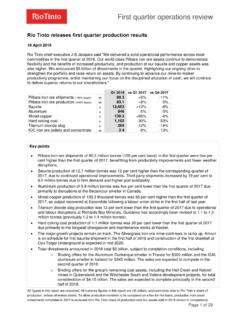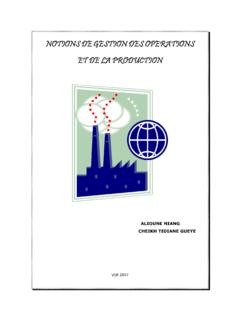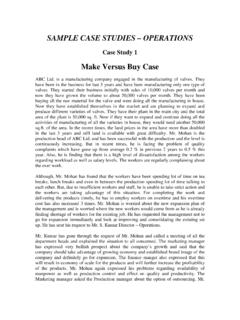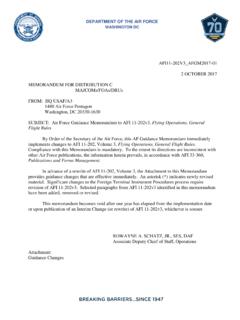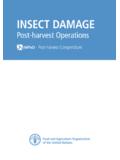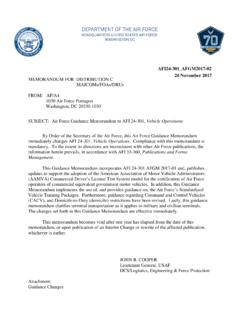Transcription of VANILLA - Food and Agriculture Organization
1 VANILLAPost-harvest operations - Post-harvest CompendiumVanilla: Post-harvest operations Authors: Javier De La Cruz Medina, Guadalupe C. Rodriguez Jim nes, and Hugo S. Garc a Co-authors: Thelma Luc a Rosado Zarrabal, Miguel ngel Garc a Alvarado and V ctor Jos Robles Olvera Last reviewed: 16/06/2009 Contents 1. Introduction .. 1 Economic and social impact of the VANILLA crop .. 11 World trade .. 13 Primary product .. 16 Alternative products from VANILLA .. 20 Requirements for export and quality assurance .. 21 Varieties and commercial cultivars .. 25 2. Harvesting and Post-production operations .. 26 Harvesting .. 26 Yield .. 29 Packing .. 30 Packinghouse operations .. 31 Pre-treatments .. 34 3. Pest species and pest control and decay .. 41 4. Bibliography .. 46 5. Glossary (List of Terms) .. 49 6. Acknowledgment .. 50 1. Introduction VANILLA ( VANILLA planifolia A.) is a major natural flavor widely used in many industries as food, beverages, sodas, pharmaceutics, cosmetics tobacco and traditional crafts.
2 VANILLA beans originated in Mexico, and in some Central American countries as Costa Rica and Honduras. However, today VANILLA beans are cultivated in many areas of the world and the main producing countries are (Fig. 1) Madagascar, Indonesia, China, Comores and in a lesser extent Tonga, Reunion, Turkey and Guadeloupe. In M xico, the main producing area is located in the Totonacapan, located in the northern part of the state of Veracruz. In recent years the Mexican states of Oaxaca and Puebla have joined Veracruz for production and processing of VANILLA beans (Musalem, 2002). VANILLA : Post-harvest operations Page 2 VANILLA beans producing areas Chemical composition of processed VANILLA Composition of processed VANILLA beans is fairly variable and complex due to a number of variables such as species, growth conditions, soil composition, fruit maturity and mainly, the type of processing. All these variables define the relative content of the chemical constituents in the processed beans, which makes it difficult to define their typical composition.
3 Ranadive (1994) reported a composition based on literature reports. In a general manner, processed beans contain vanillin, vanillic acid, p-hydroxybenzoic acid, p-hydroxybenzaldehyde, proteins, sugars, fiber as hemicellulose and cellulose, waxes, resins, pigments, tannins, minerals and essential oils. Most of these components have been reported by Rao & Ravishankar (2000) and are shown on Table 1. Table 1 Chemical composition of processed VANILLA beans COMPONENT g/kg bean ( ) Vanillin 20 vanillic acid 1 p-hydroxybenzaldehyde 2 p-hydroxybenzoic acid Sugars 250 Lipids 150 Cellulose 150-300 Minerals 60 Water 350 (Rao & Ravishankar, 2000). a) Origin From historic archives, the first data on VANILLA dates back to 1427-1440 AD, which is period when the Aztecs conquered the Totonacan empire, which offered VANILLA to the conquerors as a duty. VANILLA was named tlil-xochitl in Nahuatl, which means black flower.
4 The Aztecs used VANILLA as flavor and aroma ingredient for chocolate, a drink destined only for Aztec noble families. Spaniards took VANILLA to Europe in 1519, when Hern n Cort s sent Francisco VANILLA : Post-harvest operations Page 3 Montejo y Portocarrero to Spain as bearer of the profits from the expedition, together with a number of novel products, including VANILLA . In 1793 VANILLA was taken to Paris botanical gardens, and then to England. In 1822 VANILLA plants from France were sent to Reunion island from where this orchid was propagated through the Indic ocean countries. By 1850, more plants were taken from Reunion and Paris to Madagascar, where the crop became an important source of income such that Madagascar is now the largest producer of VANILLA in the world (Rao and Ravishankar, 2000). b) Taxonomy VANILLA planifolia (also known as VANILLA fragrans Salisb. Ames) is the most important and most studied variety.
5 Purseglove et al. (1981) described nearly 110 VANILLA species distributed in tropical regions of the world. VANILLA planifolia belongs to the orchids family, la large family that comprises ca. 700 genera and over 20 000 species. However, VANILLA is the only edible fruit that contains relevant flavor and aroma compounds (Ranadive, 1994; Rain, 1996). Taxonomy of VANILLA was described by Mabberley et al. (1997) and depicted in Table 2 Table 2 Taxonomical classification of VANILLA Kingdom Vegetal Type Fanerogamae Class Monocotyledonae Order Microspermae Family Orchidaceae Tribe Vanilleae Blume Genre VANILLA Swartz Species VANILLA planifolia Andrews VANILLA pompona Schiede VANILLA tahitense Moore (Mabberley et al., 1997) c) Botanical description There are three main systems for intensive cultivation of VANILLA , which are dependent on the type of soil. Two systems use native trees as Acahuales or native forest trees; while the third system is used for areas without trees.
6 In each system, the goal is to attain 2 Tonnes of green VANILLA beans per hectare, propagation material (cutting) totally productive and extend the productive life of the VANILLA orchard to five years of full production. d) Cultivars Characteristics of the main vainilla varieties of the world VANILLA : Post-harvest operations Page 4 Species Vainilla fragans Cultivation areas Bourbon islands, Indonesia, M xico and Tonga. Flavor profiles Typical with soft creamy end notes, full aftertaste to dry fruits that reminds to cinnamon extract. Aroma is round and equilibrated, and represents the most complete profile of all VANILLA extracts. Market The one with the highest demand for all industries. Species Vainilla tahitensis Cultivation areas Exclusively the islands of Tahit and Moorea Flavor profile A quick release of initial flavor and relatively sweet, with greasy notes and somewhat weak. Market This flavor has its highest demand in the French and Italian markets, mainly for ice cream manufacturing.
7 Species Vainilla pompona Cultivation areas Exclusively in the islands of Guadeloupe and Martinica. Flavor profile Market Its main area of application is pharmaceutics and perfumes (Claridades agropecuarias,2002) e) Cultural practices Environmental requirements of the crop Weather. VANILLA cultivation requires a temperature range of 21 to 32 C, an evenly distributed annual precipitation of 1500 mm or more, 80% relative humidity and altitudes of 0 to 600 m above sea level. Soil. The main characteristics that soils must meet for VANILLA production are: good drainage, abundant organic material and pH values of 6 to 7. It is important to note that intensive production requires tutor trees and then soil depth should be 40 cm or more. Land orientation Production sites where slopes predominate, it is better to select lands that are covered by sunlight during the mornings, with an Eastward orientation. This is to avoid moisture reduction in the soil and overdry the plant (leaf burn) and beans by the afternoon sun.
8 Land preparation Preparations are made based on the height of the native trees of the site selected for VANILLA production. The land is called forest type if trees taller than 10 m and wider than 50 cm diameter predominate; acahual-type is called if bushes and tress smaller than 10 m and widths smaller than 20 cm predominate; when there are no trees or bushes, the land is called deforested. Preparation of forest-type land Weeds must be controlled and branches that extend to less than 4 m from the ground, along with damaged branches, regardless of their height; small trees and bushes located under the shadow of taller trees should be eliminated to improve shadow distribution and ventilation to 50%. Cut plant material is usually shredded and used as mulch as organic matter source, while large pieces of logs are just discarded. When this is done, tutors are planted which will support the VANILLA plants. Preparation of acahual-type land.
9 As above, weeds need to be eliminated and mulch is prepared from dried branches. Bushes that will provide shadow and support are selected; these bushes should have one stem only, no branches should lay on the ground, with a height of m with shadows in excess of 2 m VANILLA : Post-harvest operations Page 5 height. Trees or bushes taller than 2 m should be used as shadow providers only. After this is done, the land is ready for the tutors. Natural conditions of the vegetation should be considered. It is described below the systems employed to plant he tutors in the different types of land. In forest land. For forest land the system depicted is suggested: 5000 tutors are set by hectare, distributed in rows and with a distance of 1 m between tutors and rows of 2. Fig. 2 soil type for VANILLA (Curti, 1989) In acahual land. For this type of land, the system depicted in Figure 2 is suggested, comprising 6,600 tutors per hectare in double rows.
10 The system is based on two single rows where tutors are located 1 m apart. This way, there is a row of tutors, a space of 1 m, another row of tutors, a 2 m space, one row of tutors, a 1 m space, and so on. For tree land (forest and acahual), those trees that do not match the patterns of the rows for tutors must be eliminated as long as the shadow ratio is not greatly affected. In deforested land. For this type of land tutor planting described in Figure 3 is recommended. In this scheme, 10000 tutors per hectare are established distributed in a 1 m by 1 m frame. VANILLA : Post-harvest operations Page 6 Fig. 3 Tutors (cocuites) for VANILLA , (Curti, 1989) For all three systems, it is recommended to use the pichoco Eritrina sp. as tutor. In deforested lands, it is more convenient to use 50% pichocos and 50% cocuites (Gliricidia sepium), since pichocos are not overly abundant. Planting of these two species must be alternated.












